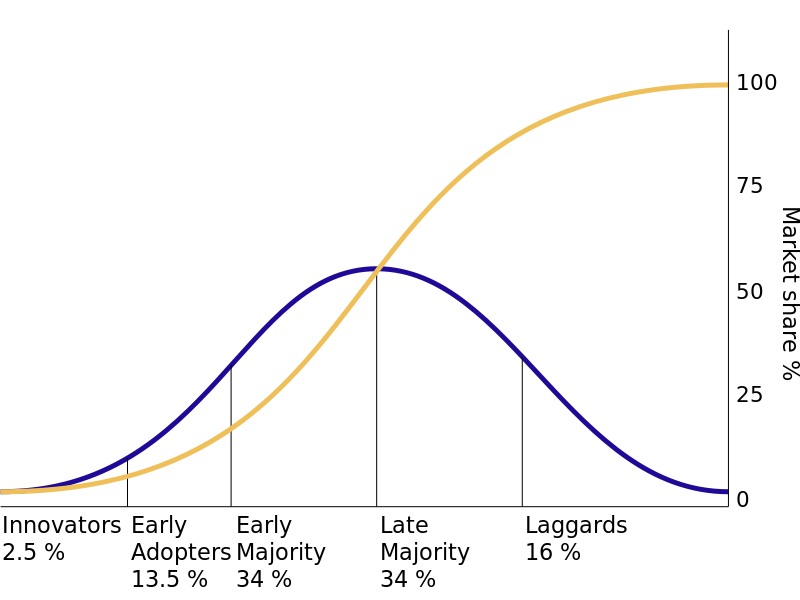Ever since I was introduced to Everett Rodgers’, Diffusion of Information, I have been fascinated with how ideas propagate through our world. In his study of Iowan farmers and how they learned about new seeds to plant, he categorized the spread of information based on innovators, early adopters, the early majority, the late majority, and the laggards. Substantial work has been done on this basic model over the nearly 50 years since Rodgers's book. A new study, published in Nature Communications, looks at how each individual decides whether to adopt or not. It seems to be the balance between continuing as they have or following their herd in a new direction.

The researchers recruited 148 subjects into a multi-round game where they chose between two strategies. After each round, the participants were told how many chose one or the other and were asked to choose again. The game continued until all agreed on one strategy or 24 rounds. A reward for achieving consensus was divided among the participants in proportion to how often they chose the winning strategy over the rounds. The purpose of the compensation was to foster collaboration and reach consensus quickly.
There was one fly in the ointment. Unbeknownst to the human participants, several bots were also participating. In the early rounds, they were programmed to move towards consensus, in the later rounds to “stubbornly” choosing the non-status quo strategy – they were the “tyrannical minority.”
- In the first 1-3 (early) rounds, a strategy was quickly established as dominant. (status quo)
- In 80% of cases, there was a switch to the “bot inspired” alternative, and it happened very quickly – a determined minority moved the majority in a new direction. The alternative quickly diffused through the majority.
- When looking more closely at the decisions made by those switching, the researchers identified “explorers” open to trying something new and non-explorers, who commit to the new strategy when it seems inevitable. In Rodgers classification, the explorers were the early adopters, the non-explorers, the late majority.
If we generalize the experiment to all of us, it suggests that we follow the herd balancing our comfort with the status quo with our discomfort with being “different.” But, here’s the thing, those bots turn the choice around by being stubbornly obstinate; it only required 25% of the participants to be the tyrannical minority to evoke the change. Think about that. Far different from the idea of “majority rule” that we were all taught.
The researchers made some general conclusions:
- There is always a delay in changing course, and the delay increases directly with the numbers of non-explorers, those satisfied with the status quo, driven by inertia.
- In the absence of explorers, perhaps now is a good time to introduce the word “influencers,” there is no change. A few explorers must be present to get the ball rolling, overcome the inertia.
- A committed minority of explorers, roughly 20%, are necessary to trigger social change. Below that number, diffusion takes too long; inertia cannot be overcome as the committed minority fades away or another “better” alternative appears. Above that level, change can come quickly from the status quo to the alternative, like a phase shift – one moment water, the next ice.
Of course, this is a model, so the actual numbers are not set in certainty. And in the real world, other factors will and do come into play. But the research shows that a committed minority can move the herd in a new direction. We have seen this over and over. From the banning of peanuts on aircraft to the 1964 Civil Rights Act to the continued lack of gun regulation – the views of a committed minority move the majority in a new direction. As the balance between Rodgers’s early majority and the undecided in the herd increases, the change comes swiftly.
To return for a moment to the phase shift analogy, supercooled water will turn to ice instantaneously when an ice crystal is introduced; the older version of that heuristic refers to the straw that broke the camel’s back. Here’s a question you might ponder, have the vaccine mandates been that ice crystal?
Source: Collective patterns of social diffusion are shaped by individual inertia and trend-seeking Nature Communications DOI: 10.1038/s41467-021-25953-1
By Rogers Everett - Based on Rogers, E. (1962) Diffusion of innovations. Free Press, London, NY, USA., Public Domain, https://commons.wikimedia.org/w/index.php?curid=18525407




